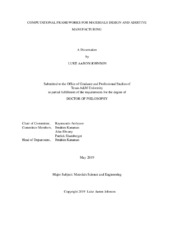| dc.contributor.advisor | Arroyave, Raymundo | |
| dc.creator | Johnson, Luke Aaron | |
| dc.date.accessioned | 2019-10-15T16:20:45Z | |
| dc.date.available | 2021-05-01T12:34:13Z | |
| dc.date.created | 2019-05 | |
| dc.date.issued | 2019-02-07 | |
| dc.date.submitted | May 2019 | |
| dc.identifier.uri | https://hdl.handle.net/1969.1/184405 | |
| dc.description.abstract | The discovery of new materials is a necessary component for the advancement of humanity as a species, which is evidenced by the common practice of delineating major eras of humanity by the materials associated with the most advanced technologies of the time: Stone, Bronze, Iron, etc. The introduction of new materials has progressed beyond discovery of new elements to the development of highly specialized materials that possess properties far greater than the sum of their elemental constituents. Traditional experimental techniques for optimizing these materials are often outpaced by the rapid development cycles of the technologies that they ultimately enable. Fortunately, the same computational power that has allowed faster technology development overall can also be used to accelerate materials development. This is accomplished by supplementing experimental results with physics-based simulations that improve extrapolative predictions beyond our current state of knowledge. There are a multitude of issues to consider when developing a coupled approach between experimental and computational methodologies. Engineering design principles can aid in the codevelopment of both experiments and simulations by providing a common ground and a common set of tools to formalize the problem/objective. The four parts of this dissertation are primarily focused on the development of computational frameworks for the design of new materials and/or processing conditions. In the first work, a materials design framework based on the idea of Efficient Global Optimization was developed to optimize the ratio of Aramid Nanofibers, Graphene Oxide, and Carbon Nanotubes within a composite supercapacitor electrode, subject to a user defined preference for the tradeoff between mechanical and electrochemical performance. The second work establishes a novel technique for quantifying and visualizing the uncertainty associated with precipitation model predictions used to tailor the transformation behaviour of a Ni-48wt.%Ti shape memory alloy. The third work details the coupling of the aforementioned precipitation model with a symmetry-enhanced Finite Element thermal model to look at secondary phase formation during additive manufacturing of a Ni-49.1wt.%Ti shape memory alloy. The fourth work presents a computational framework for predicting the printability of alloys for additive manufacturing and shows very good agreement with experimental observations from a Ni-5wt.%Nb alloy, and an equiatomic CoCrFeMnNi alloy. | en |
| dc.format.mimetype | application/pdf | |
| dc.language.iso | en | |
| dc.subject | Materials Design | en |
| dc.subject | Additive Manufacturing | en |
| dc.subject | Precipitation | en |
| dc.subject | Finite Element | en |
| dc.title | Computational Frameworks for Materials Design and Additive Manufacturing | en |
| dc.type | Thesis | en |
| thesis.degree.department | Materials Science and Engineering | en |
| thesis.degree.discipline | Materials Science and Engineering | en |
| thesis.degree.grantor | Texas A & M University | en |
| thesis.degree.name | Doctor of Philosophy | en |
| thesis.degree.level | Doctoral | en |
| dc.contributor.committeeMember | Elwany, Alaa | |
| dc.contributor.committeeMember | Karaman, Ibrahim | |
| dc.contributor.committeeMember | Shamberger, Patrick | |
| dc.type.material | text | en |
| dc.date.updated | 2019-10-15T16:20:45Z | |
| local.embargo.terms | 2021-05-01 | |
| local.etdauthor.orcid | 0000-0001-9571-306X | |


